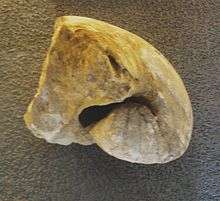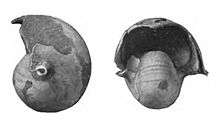Eutrephoceras
Eutrephoceras is an extinct genus of nautilus from the Late Jurassic to the Miocene (around 161 to 5 million years ago). They are characterized by a highly rounded involute shell with slightly sinuous suture patterns.
| Eutrephoceras | |
|---|---|
 | |
| Eutrephoceras depressum | |
| Scientific classification | |
| Kingdom: | Animalia |
| Phylum: | Mollusca |
| Class: | Cephalopoda |
| Subclass: | Nautiloidea |
| Order: | Nautilida |
| Family: | Nautilidae |
| Genus: | †Eutrephoceras Hyatt, 1894 |
| Type species | |
| Nautilus dekayi Morton 1834 | |
| Species | |
|
See text | |
_-_Strasbourg_specimen.jpg)

Description
Eutrephoceras typically possess nearly globular conchs (shells). The whorls are reniform (kidney-shaped) in cross section and broadly rounded on the sides and lower edge.[1] On the upper edge it is only slightly curved. The surface of the shell is usually smooth, but can sometimes be sculptured. The suture patterns are slightly sinuous, though it can be more or less straight in some species. The umbilicus is small and barely noticeable, sometimes hidden altogether. The septa are averagely convex towards the tip. The siphuncle is small and circular in cross section. It can vary in position considerably and its placement is important in identifying different species under the genus, but it is never marginal.[2]
Puncture marks made by teeth on several Eutrephoceras fossils (such as E. campbelli, of the Trent River Formation in Vancouver) are cited as evidence of mososaur predation on this genus.[3]
Distribution
Eutrephoceras can be found in Late Jurassic to Miocene formations confirmed in many places in the earth, and many species are valid.[2]
Taxonomy
Eutrephoceras is classified under the family Nautilidae, which includes the only extant nautiloids of the genera Allonautilus and Nautilus. They are part of the superfamily Nautilaceae, the only superfamily of nautiloids to survive past the Triassic.[4] Eutrephoceras are sometimes separated into the monogeneric family Eutrephoceratidae as first proposed by A.K. Miller in 1951,[5] but most authors include it under Nautilidae.[2]
Species under Eutrephoceras include the following. This list is incomplete.[6]
- Eutrephoceras antarcticum Landman et al., 2004
- Eutrephoceras berryi Miller 1947
- Eutrephoceras bryani (Gabb 1877)
- Eutrephoceras campbelli [3]
- Eutrephoceras carolinensis Kellum 1926
- Eutrephoceras cookanum (Whitfield 1892)
- Eutrephoceras dartevellei Miller, 1951
- Eutrephoceras dekayi (Morton 1834) (type)
- Eutrephoceras dorbignyanum (Forbes in Darwin, 1846)
- Eutrephoceras eyerdami Palmer, 1961
- Eutrephoceras hallidayi (Waring 1914)
- Eutrephoceras hannai Vokes 1937
- Eutrephoceras japonicum (Shimizu 1926)
- Eutrephoceras johnsoni Miller 1947
- Eutrephoceras jonesi Miller and Thompson 1933
- Eutrephoceras laverdei Durham, 1946
- Eutrephoceras marksi Miller 1947
- Eutrephoceras oregonense Miller 1947
- Eutrephoceras reesidei Stenzel 1940
- Eutrephoceras simile Spath 1953
- Eutrephoceras sloani Reeside 1924
- Eutrephoceras sphaericum (Forbes 1846)
- Eutrephoceras stephensoni (Dickerson 1914)
References
- Neal L. Larson; Steven D. Jorgensen; Robert A. Farrar; Peter L. Larson (1997). Ammonites and the Other Cephalopods of the Pierre Seaway. Geoscience Press, Inc. p. 96. ISBN 0-945005-34-2.
- Marcela Cichowolski; Alfredo Ambrosio; Andrea Concheyro (2005). "Nautilids from the Upper Cretaceous of the James Ross Basin, Antarctic Peninsula". Antarctic Science. 17 (2): 267–280. doi:10.1017/S0954102005002671.
- Ludvigsen, Rolf & Beard, Graham. 1997. West Coast Fossils: A Guide to the Ancient Life of Vancouver Island. pg. 117
- B. Kummel (1964). "Nautiloidea-Nautilida". In C. Teichert; R.C. Moore (eds.). Treatise on Invertebrate Paleontology. Part K. ISBN 0-8137-3011-2.
- Neil H. Landman; Ralph O. Johnson; Lucy E. Edwards (2004). "Cephalopods from the Cretaceous/Tertiary boundary interval on the Atlantic Coastal Plain with a description of the highest ammonite zones in North America. Part 2. Northeastern Monmouth County, New Jersey". Bulletin of the American Museum of Natural History (287): 1–107.
- "Eutrephoceras Hyatt 1894". Paleobiology Database. Retrieved February 21, 2012.
External links
![]()
![]()